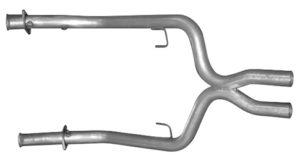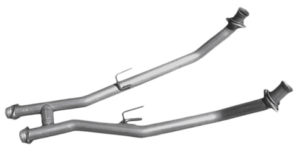You may be wondering why so many aftermarket performance exhaust system manufacturers are offering dual exhaust systems connected by “H-pipe” or “X-pipe” sections. After all, aren’t two separate pipes, or so-called “true duals”, the best for performance? The answer is no, but to understand why we have to examine how a typical internal combustion engine works.
In short, H- and X-pipe exhaust sections benefit V6 and V8 engines because they connect separate pipes coming from the two different exhaust banks found on those engines. Inline engines where all the cylinders are in a row gain nothing, because they have only one exhaust bank.
The consensus opinion among exhaust flow experts is that any V8 engine will benefit from an H-pipe or X-pipe section mounted on a dual exhaust system. Others feel X-pipes are better suited to free-revving overhead cam V6s and V8s, while H-pipes are a natural fit for high-torque big-block V8 engines that make their power lower on the rpms scale.

A typical X-pipe exhaust section

a typical H-pipe exhaust section
If you hold your hand behind a tailpipe, the exhaust flow feels like a continuous stream, but it’s actually a series of pulses, each of which is created every time one cylinder’s exhaust valve opens in the firing order. On a typical V8 engine, one cylinder on each bank fires within 90 degrees of crankshaft rotation of another cylinder on the same bank. The resulting exhaust pulses are very close together as they travel through the exhaust system and on some vehicles they create a popping noise.
H-pipe sections were first installed to quiet this exhaust noise. When the two close firing cylinders are exhausting on one bank, there is nothing happening in the other bank, so connecting both pipes effectively enlarged the exhaust system, allowing these exhaust pulses to exit through both sides of the system. It was found that, with the addition of an H-pipe, exhaust noise could be reduced by as much as 2 decibels.
Adding an H-pipe section also increases power. Even when headers are installed, these close firing cylinders are competing for space in the exhaust pipe after the collector, which creates backpressure and reduces power. Connecting the exhaust pipes allows pressure to escape to the other side of the system, with a resulting gain in low-end and mid-range torque. However, the effectiveness of an H-pipe section decreases somewhat at higher rpm. The increased exhaust gas velocity at high rpm causes most of the exhaust to take the path of least resistance and continue down the exhaust pipe, rather than make the turn into the H-pipe.
The solution to this problem is the X-pipe. With an X-pipe section, the two sides of the exhaust system are merged rather than just connected, allowing the exhaust from each bank to easily flow into both exhaust pipes. The exhaust pressure on both banks is equalized and power is increased at all engine speeds.
As with the H-pipe, an X-pipe also affects the sound of the exhaust. Testing by one exhaust manufacturer indicated an X-pipe equipped system was several decibels quieter than an equivalent H-pipe system. And although sound quality is subjective, many have described the exhaust note from an X-pipe system as higher pitched and smoother than an H-pipe system.
Source: Carid
